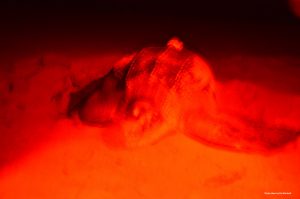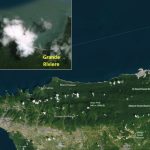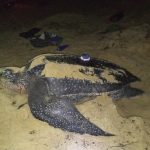
This is the best photograph of Daisy that we have. It was taken the first time she nested this year–at Grande Riviere in March. Atlantic leatherback turtles usually nest every two to three years. But, during the years they do nest, they typically lay between five and seven clutches (nests) of eggs. These nests are laid at ten-day intervals. The night Kyle and Sarah were waiting for Daisy would have been her third nesting event. Photo credit: Pat Marshall
We haven’t heard anything more from Daisy. Not since that last satellite tag detection near the coast on the morning before we were expecting her to nest.
Sometimes a turtle’s transmitter fails because of a process called “biofouling.” Small plants (like algae) and/or organisms (like barnacles) colonize the tag and prevent it from working properly. When this happens, we typically see the quality of the satellite hits deteriorating over time. This did not happen with Daisy’s tracking data. Her tag just stopped transmitting all of a sudden.
Sometimes, a turtle’s transmitter fails because it is knocked off during mating. But we know from the male leatherbacks we have tracked in the past that mating in the western Atlantic is usually finished by April.
And sometimes leatherbacks are accidentally caught in artisanal gillnet fisheries off the coast of Trinidad, including those in the area where Daisy was when we last heard from her. If entangled turtles are found in time, they can be released alive. But leatherbacks (and all sea turtles) breathe air. And so often, they drown.
We don’t know what happened to Daisy, but it seems like this is a reasonable possibility.
In my imagination, we can keep “our” turtles safe. That somehow, because we are tracking them—because they mean so much to us—they’ll be okay. Shielded by some invisible force from the reality of the threats these animals face to their survival. It’s a silly thing to think on my part. Wishful.


